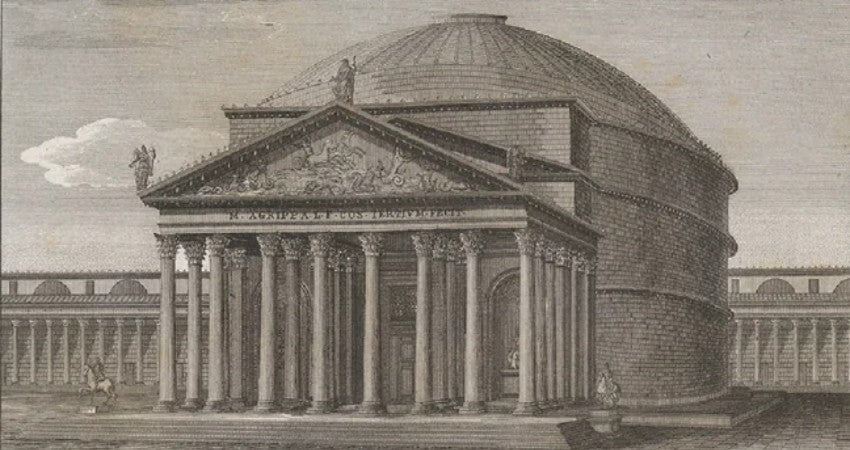
View of the Pantheon of Canina
Alice PettirossoShare
Luigi Canina 's " Prospettiva del Pantheon " represents an extraordinary testimony to the study of ancient architecture and the interest in the ruins of Rome in the 19th century. Canina , an architect and archaeologist by training, emerged as a key figure in the neoclassical movement, dedicating his career to the valorization and graphic reconstruction of Roman monuments. This work embodies his analytical and creative vision, offering an accurate and fascinating representation of the Pantheon , symbol of the cultural heritage of antiquity.
Historical context and patriotic intent
In the 19th century, Italy was politically fragmented and in search of a unified national identity. Canina , through the " Prospetto del Pantheon ", not only documents classical architecture, but also reflects the cultural and political aspirations of his time . He uses the Pantheon as a symbol of a past greatness to be rediscovered and adapted to the present, placing ancient architecture at the center of a debate on the common Italian heritage. His work thus presents itself as a patriotic act , aimed at rediscovering and celebrating the cultural roots of the nation, promoting unity through knowledge of its origins.
Structure and technical analysis of the work
Canina 's work stands out for its rigorous and meticulous structure . He reconstructs the frontal aspect of the Pantheon with extreme attention to detail: from the Corinthian columns to the decorated architrave, up to the imposing pediment. The centered perspective gives a sense of majesty, evoking the grandeur of Roman civilization. The " Pantheon Prospectus " is a historical and didactic document that illustrates the architectural characteristics of the ancient.
From a technical standpoint, Canina 's engraving is a masterpiece of precision. The skillful use of lines gives the work an almost photographic realism, while the light shading creates a play of light that enhances the three-dimensionality of the building. The mastery of chiaroscuro highlights the differences in depth and materials , underlining the monumentality of the Pantheon. This attention to detail places Canina in the tradition of great vedutisti such as Giovanni Paolo Panini, although he adopts a more analytical and scientific style than contemporaries such as Giovanni Battista Piranesi. While Piranesi focuses on the dramatic aura of the ruins, Canina offers a precise and didactic representation, aimed at faithfully reconstructing the original appearance of the monuments.
The Pantheon: History and Meaning
The Pantheon , originally built by Agrippa between 27 and 25 BC, has undergone many transformations, particularly under the emperor Hadrian. Initially dedicated to all the Roman deities, it was later converted into a Christian church in 608 AD, which has allowed it to be preserved to the present day. This has made it a model of inspiration for European architecture and, in particular, for the neoclassical movement.
In his " Prospettiva ", Canina represents the Pantheon in all its grandeur, emphasizing the perfection of the building's proportions . Through this work, he contributes to defining the aesthetic canons of neoclassicism , highlighting how the principles of ancient architecture can be revived and reinterpreted in contemporary culture. The influence of the Pantheon extends from the Renaissance to the 19th century, inspiring many neoclassical architects.
Interaction between archaeology and neoclassicism
Canina 's work stands at the crossroads between scientific archaeology and the neoclassical movement . At a time when archaeology and art were collaborating to rediscover and document the glory of antiquity , Canina fuses the two disciplines, creating a work that is both precise documentation and artistic expression . His representation of the Pantheon is based on the most advanced discoveries and theories of the time, including studies of the proportions, materials and construction techniques of antiquity.
However, Canina does not hesitate to integrate hypothetical elements to fill historical gaps, guided by his knowledge and intuition. In this sense, the "Pantheon Prospectus" anticipates modern restoration techniques , which often have to combine historical data with scientific suppositions. Canina 's work, therefore, becomes a testimony to the knowledge and hypotheses of his time.
Dialogue with other artists and works
The " Prospettiva del Pantheon " enters into dialogue with the neoclassical masterpieces of the time . Antonio Canova , for example, immortalized classical purity and perfection in his sculptures, while Canina , through his drawings, revives Roman monuments in their original form. Similarly, the engravings of Giovanni Battista Piranesi represent antiquity with dramatic majesty, but Canina stands out for his more scientific and didactic approach .
Canina's works , including "Ancient Architecture Described and Demonstrated with Monuments" and "The Buildings of Ancient Rome", testify to his dedication to documenting and interpreting the architectural heritage with a careful eye on historical sources. The " Prospettiva del Pantheon " fits into this tradition, exemplifying his analytical approach in representing Roman monumental buildings.

